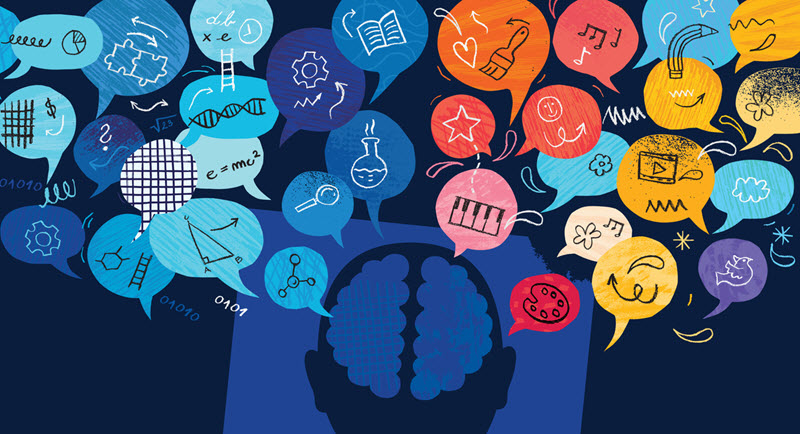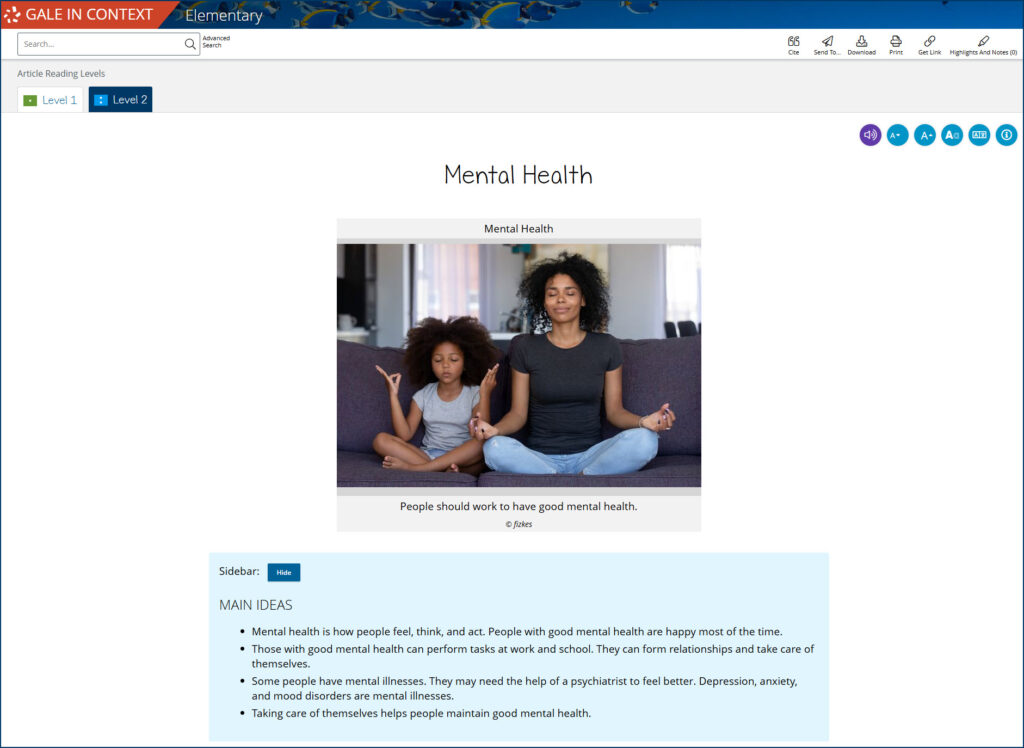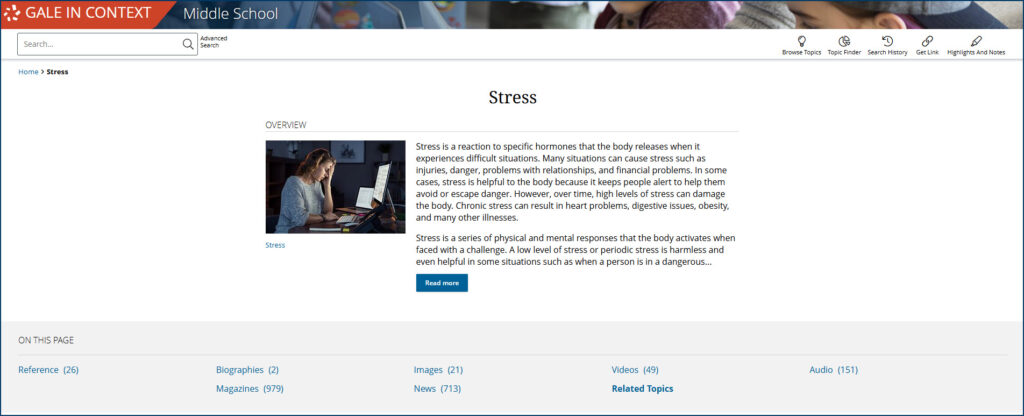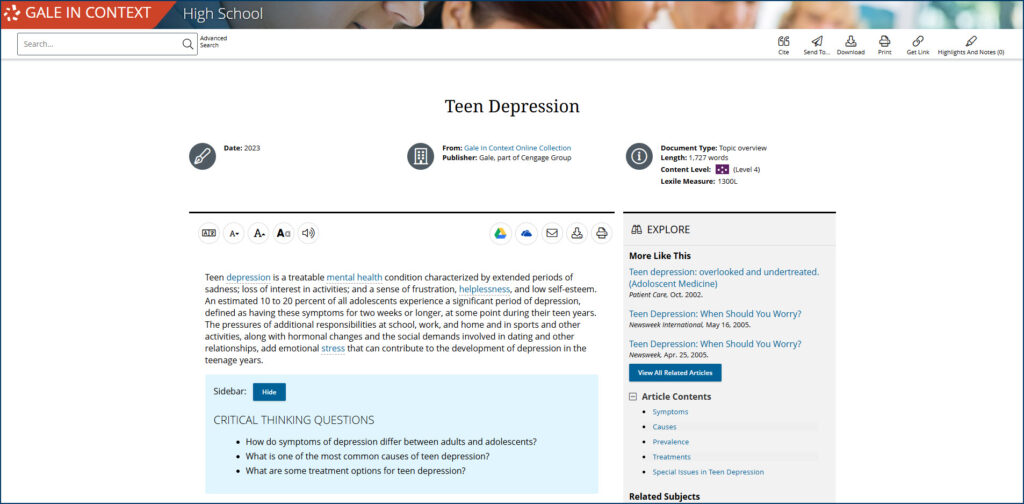| By Gale Staff |
The United States is experiencing a youth mental health crisis. Many potential factors contribute to the concerning situation, ranging from pandemic-era social isolation and political instability to social media use and financial uncertainties.
The statistics are staggering: in 2020, one in six U.S. adolescents experienced a major depressive episode, and one in three young adults suffered from some form of mental illness. Experts agree that school-based interventions, including programs that encourage social connectedness, health education, and increased access to mental health services, are all critical steps toward a solution.
May is Mental Health Awareness Month. Established in 1949 by Mental Health America, the monthlong observance offers a platform for conversation, care, and support. While we’ve come a long way since the 1940s to address the shame and silence around mental health, there’s still more work to do.
This Mental Health Awareness Month, turn to your Gale In Context subscription for age-appropriate content to elevate your school’s mental health initiatives. Gale In Context resources are educator-vetted and grade-specific, so you can feel confident as you integrate a sensitive topic into your classroom space.
Talk About Mental Health Early
Classrooms are well-positioned to create a healthy foundation for children’s perceptions around mental health. According to the National Institutes of Health, “Proactively addressing mental health issues in educational settings can help to reduce the stigma associated with mental health challenges.”
For elementary students, integrating mental health–related topics into daily lessons can play a crucial factor in normalizing these discussions, expanding their emotional vocabulary, and modeling healthy coping skills. As a teacher, your role in this early education is vital. The information and activities housed in Gale In Context: Elementary can help facilitate age-appropriate discussions around common disorders and kid-friendly self-care habits.
Healthy relationships are an important contributing factor to mental and emotional wellness. Gale In Context: Elementary houses reliable resources on building healthy relationships, helping students identify personal connections, whether with peers, family members, or even teachers, and then defining what makes them healthy—such as open communication, trust, boundary-setting, and respect.
By fostering a clearer understanding of healthy relationships and helping students avoid unhealthy ones, educators can guide students toward a secure foundation for emotional development. These social connections play a significant role in reducing the risk of mental health problems like anxiety, depression, and low self-esteem. Your efforts in this area can have a profound and lasting impact on your students.
Activity Ideas: For Mental Health Awareness Month, Gale’s support team created two elementary-level activities:
- Using Gale In Context: Elementary, have students research common emotions like happiness, sadness, anger, or fear. Our printer-ready KWL chart can help them track their learning. Assisting children to learn different emotions can help them recognize and communicate their own feelings when they need support.
- Teach essential stress management with our scavenger hunt activity. The worksheet directs students through our stress management portal with simple, guided questions.
Embrace Change with Middle Schoolers
Middle school is a major transition period—physically, academically, and emotionally. Your “tweens” are likely navigating a new school and absorbing any number of new stressors. Around this age, especially as their bodies change, middle schoolers may experience insecurity and increased anxiety around personal relationships. In fact, around half of all mental health issues begin by age 14. Gale In Context: Middle School has resources that can assist students in developing valuable coping skills for this challenging phase.
Stress is normal, but people need tools to manage it. Too much stress can trigger and worsen mental health conditions, including anxiety, depression, and trouble concentrating. Stress even causes physical reactions, such as headaches and back pain. If sustained, it can worsen into substance abuse and eating disorders.
Educators can model healthy stress management by implementing easy and fun de-stressors throughout May. Small moments for meditation, time outdoors (recess is important for middle schoolers, too), yoga classes, and journaling are accessible strategies students can use at home and as they grow. Gale In Context: Middle School has great stress management recommendations, including videos and audio files.
Activity Ideas: For Mental Health Awareness Month, Gale’s support team created two activities specifically geared toward middle school students:
- Using Gale In Context: Middle School, have students choose one of the following mental health conditions to investigate: anorexia, anxiety, autism, depression, or stress. They can fill out the associated KWL chart as they investigate. Researching these topics can help middle schoolers understand their personal mental health, symptoms, and how to discuss and ask for support.
- This scavenger hunt activity, for grades 6–8, walks students through the database’s mental health portal. Topics include psychotherapy and “drug-free” stress management interventions—strategies to promote healthy lifestyles linked with improved mental health.
Destigmatize Depression with High Schoolers
High school is a critical life stage defined by increased academic and social pressure. Your adolescent students may be starting their first jobs, preparing for college, experiencing some degree of financial and social independence, or possibly experimenting with alcohol, drugs, and sex. The significant physical and emotional changes high schoolers face can precipitate underlying mood disorders and cause extended feelings of sadness and depression.
According to a 2024 national survey, 40% of high schoolers reported consistent feelings of sadness, and 20% have considered suicide. These numbers are scary, but it’s important not to shy away from this reality.
Gale In Context: High School can assist your school in normalizing conversations about depression (in addition to other mental health issues) and emphasize avenues for seeking help.
High schoolers dealing with mental health crises need to know that they are not alone in their feelings, and that help is available. Conditions like teen depression are treatable; common remediations include talk therapy and medications. Gale In Context: High School houses reliable and accessible information about depression, including symptoms, interventions, and vetted health studies.
Activity Ideas: Gale’s support team has two high school-level activities for Mental Health Awareness Month:
- The KWL chart for high schoolers encourages a deeper look into cognitive illnesses, including ADHD, bipolar disorder, post-traumatic stress disorder (PTSD), and depression. Knowledge of these topics can help high schoolers recognize symptoms and confidently seek help for themselves and others.
- Our high school scavenger hunt activity features different forms of therapy and a video about the effects of social media use on mental health. You can encourage students to read a biographical entry of their choosing—learning about others’ experiences with mental health can be a valuable way to validate issues and promote treatment.
This May, help your students connect with their mental health through age-appropriate, authoritative research and classroom-ready activities. Mental Health Awareness Month is a chance to normalize these topics, increase empathy, and reduce barriers to seeking help. If your school doesn’t already subscribe to Gale In Context, you can connect with your local representative and request a trial.




